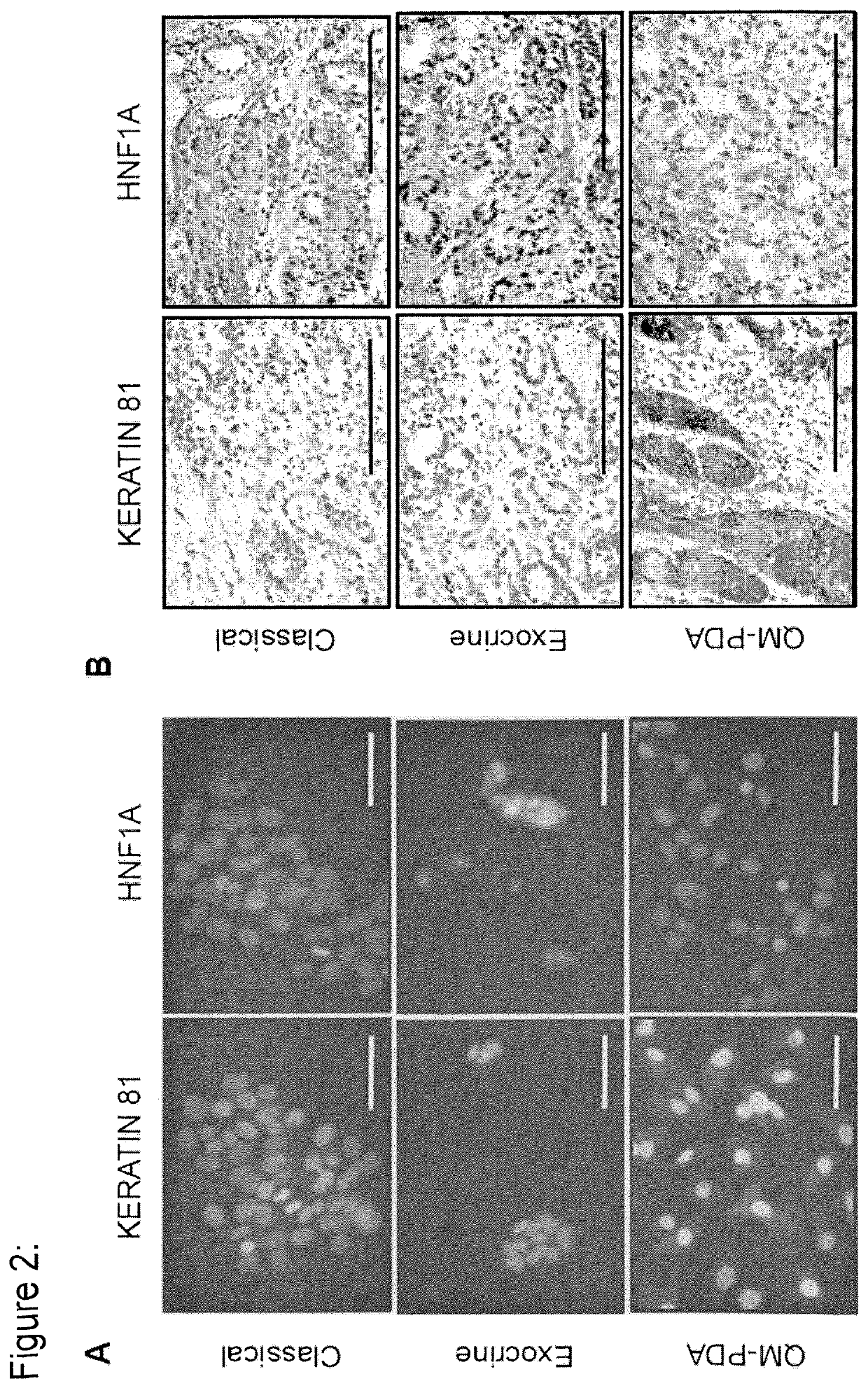Methods for sub-typing and treating cancer
a cancer and subtype technology, applied in the field of subtype and treatment of cancer, can solve the problems of limited treatment options and little or no survival benefit for pdac patients, and achieve the effect of improving prognostic evaluation
- Summary
- Abstract
- Description
- Claims
- Application Information
AI Technical Summary
Benefits of technology
Problems solved by technology
Method used
Image
Examples
example 1
Establishment of PDAC Models Representing Three PDAC Subtypes
[0106]We established a novel primary patient derived preclinical model system in vitro and in vivo, which recapitulates all three known PDAC subtypes (FIG. 1A). In detail, patient-derived PDAC specimens were surgically grafted onto the pancreas of immune-deficient NOD.Cg-Prkdcscid II2rgtm1Wjl (NSG) mice (FIGS. 1A, 1B and 9A). Tumors from successful primary xenografts (PT) were then used to propagate stable, serum-free and adherent primary cell lines termed PACO (Pancreatic AdenoCarcinOma) (FIGS. 1A, 1B and 9A). PACO lines retained high in vivo tumorigenicity after orthotopic transplantation into secondary NSG mice. Comparison of the resulting PACO derived tumors (DT) with the original patient specimen (PT) showed conservation of all central histomorphological characteristics (FIGS. 1B and 9A). Pearson correlation analysis comparing RNA expression profiles across each step of our model system yielded consistently significan...
example 2
Identification and Validation of a Novel Two-Marker Set for PDAC Subtypes
[0107]Although gene expression signatures are important tools for research, they are difficult to translate into clinical settings. Given that immunohistopathology is still the standard for tumor evaluation, we sought to identify protein markers for each of the PDAC subtypes, which could be applied for patient stratification. First, a list of genes showing strong (>5 fold, p<0.05) differential expression between the PACO subtypes was established. Then, this list was refined using the Protein Atlas database (Uhlen et al., 2010; FIG. 9A) and candidate markers were selected in case the corresponding antibody showed specific staining in only a subset of PDAC. In parallel, the GSEA motif module (Subramanian et al., 2005) was used to identify putative subtype-specific transcription factor activity. The latter analysis revealed an exclusive enrichment of genes containing binding-sites for the homeobox A transcription ...
example 3
Exocrine-Like PDAC Cells are Resistant Towards Small Molecule Inhibitors
[0108]Previous observations suggested that PDAC subtypes differ in drug sensitivity (Collisson et al., 2011). As no previous study included the exocrine-like subtype due to lack of model cell lines, we were especially interested in the drug-response of this subtype. To address this, the PACO lines were treated with gemcitabine, erlotinib and dasatinib at 1 μM (FIG. 3A) or 10 μM (FIG. 10A) and relative cell viability was determined after 48 hours. The classical and the QM-PDA subtype were sensitive towards all drugs tested (FIGS. 3A and 10A). In contrast, the exocrine-like subtype was almost completely resistant towards all three compounds at the concentrations tested (FIG. 3A and FIG. 10A). Thus, we aimed to identify the underlying mechanisms mediating the observed drug resistance. We used GSEA to compare the exocrine-like with the classical and QM-PDA subtype, both in the PACO lines (FIGS. 3B-3C and 11B) and in...
PUM
| Property | Measurement | Unit |
|---|---|---|
| volume | aaaaa | aaaaa |
| volume | aaaaa | aaaaa |
| pH | aaaaa | aaaaa |
Abstract
Description
Claims
Application Information
 Login to View More
Login to View More - R&D
- Intellectual Property
- Life Sciences
- Materials
- Tech Scout
- Unparalleled Data Quality
- Higher Quality Content
- 60% Fewer Hallucinations
Browse by: Latest US Patents, China's latest patents, Technical Efficacy Thesaurus, Application Domain, Technology Topic, Popular Technical Reports.
© 2025 PatSnap. All rights reserved.Legal|Privacy policy|Modern Slavery Act Transparency Statement|Sitemap|About US| Contact US: help@patsnap.com



